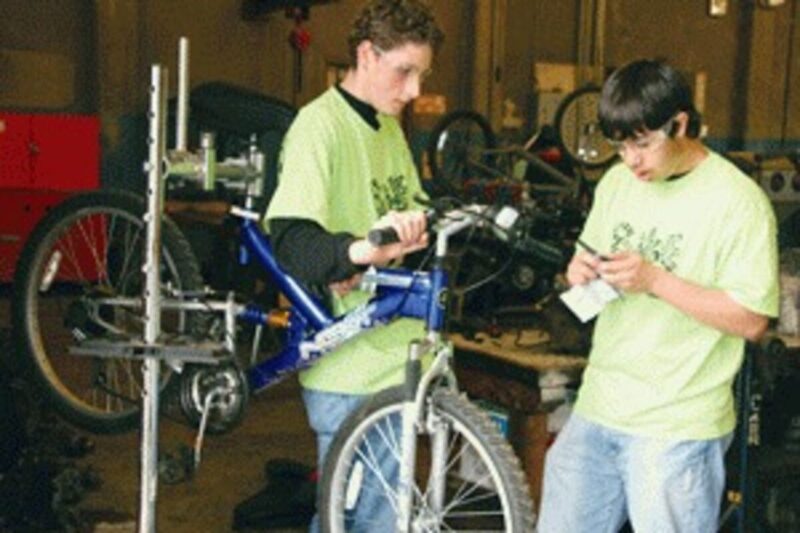Scott Swanson
Of The New Era
Steven Fox was busy, during the last week of school, putting a headlamp on his bright yellow bicycle.
Steven, 14, hunched over his small BMX-style bike in the Sweet Home High School auto shop, adjusting the mounting mechanism. Finishing the job, he took a little spin around the parking lot.
Around him, about a dozen other Sweet Home Junior High School students worked on similar vehicles as adult volunteers lent advice and help as needed.
It was another Thursday afternoon meeting of the Get In Gear Bike Club of Sweet Home, which began last February with half a dozen students and has grown to include about 20. Last Thursday was the final day for the 2006-07 school year, so students enjoyed some free pizza and cake before heading out to work on their bikes. District Nurse Joan Pappin handed out award certificates to various participants.
“We now have a pretty full room,” said Luke DeFalco, a Harley Davidson motorcycle enthusiast who also teaches math at the junior high. DeFalco volunteered to help out with the club and, when its founder and first leader, temporary teacher Fred Maxwell, moved on to another teaching assignment, he found himself in charge of the group.
Each Thursday afternoon, from 3 to 4:30 p.m., during the spring, students worked on bicycles donated by the Sweet Home Police Department, learning to fix problems and make necessary adjustments on the vehicles, most of which were stolen or abandoned. DeFalco said that students often will simply strip usable parts off bikes and combine them into a useable machine. One incentive for students to participate is that they can earn a bicycle by attending a certain number of club meetings. That’s how Steven got his.
“I like (the club) because I can fix up bikes,” he said,
The club was founded by Maxwell, an avid cyclist, and Pappin. Pappin said it is the result of a collaboration of efforts between Maxwell, DeFalco, herself, and school counselors.
DeFalco said the club’s focus initially was underprivileged students, many of whom had never owned a bike. It has since attracted teens from a much broader range of socio-economic backgrounds.
“Not all of them are there just to get a bicycle,” he said. “A lot of them are just there to have some good, clean fun.”
John Russell, 13, a seventh-grader, said that’s why he’s involved.
“It’s just fun to meet new people and get to work on bikes,” he said. “I used to work on bikes all the time, but when they got broken, I didn’t know how to fix them. But once I’ve learned how, I’m going to fix them.”
Pappin said the possibility of owning a bike is an incentive for some students involved in the club. They can qualify to take a bike home if they’ve attended three club sessions, watched a safety video and followed the rules.
“I’d guess 10 kids have earned a bike and ridden out of the building,” she said.
DeFalco said he expects the club to grow, now that the word’s getting out.
“It keeps snowballing,” he said. “It’s basically the auto shop of the junior high. It’s a good segway to auto shop at high school.”
Christian Guerrero, 14, an eighth-grader, said he was one of the original club participants and has built “about five” bikes. His sister, Estephany, a 13-year-old, is also involved.
“I love this place,” he said, adding that he likes helping other members with their bikes as well as working on his own projects.
DeFalco said he’s had parents tell him that their kids “ache” for Thursdays now that they’ve gotten involved in the club. He said part of it is just teaching them to help themselves.
“If kids know how to change a tire, that’s a big deal,” he said. “That’s why I’m there. Not all these are my (math) students. Because of cutbacks and everything else, there are not a lot of electives. I want them connected. As happy, enthusiastic students, they’re going to do better in my class.”
He said he has had a few of his own students in the club and noticed that their classwork and participation did improve.
“We have some pretty hard cases and it’s not because they’re poor, either,” he said, citing one student who got involved reluctantly, then discovered the club wasn’t for geeks after all.
“He thought it was cool. His behavior is way better and we’re better connected,” he said. “From that angle, it’s good.”
Pappin said the club isn’t an original idea. Former local bicycle shop owner Bruce Davis and others organized one years ago, she said. To get this one up and running she wrote a grant request to the Community Cycling Center, which helped provide money for helmets, repair parts, fluorescent green T-shirts designed by students, and food.
DeFalco used the $500 stipend he gets for advising the club to buy tools so the students wouldn’t have to use the high school’s tools. A spare room at the high school is filled with the bikes donated by the police.
DeFalco told school administrators and board members, who visited the club on Thursday, that he needs more storage space to handle the club’s growth.
Kathy Burrece, 15, is one of the three girls involved in the club. She said she’s participating because she likes to work on bikes.
“My favorite activity is building bikes,” she said. “I wrecked on a bike I built here, but I didn’t get hurt. Fortunately, I was wearing my helmet.”





